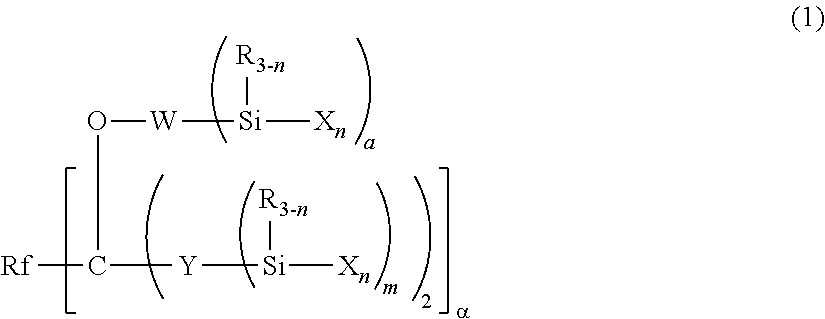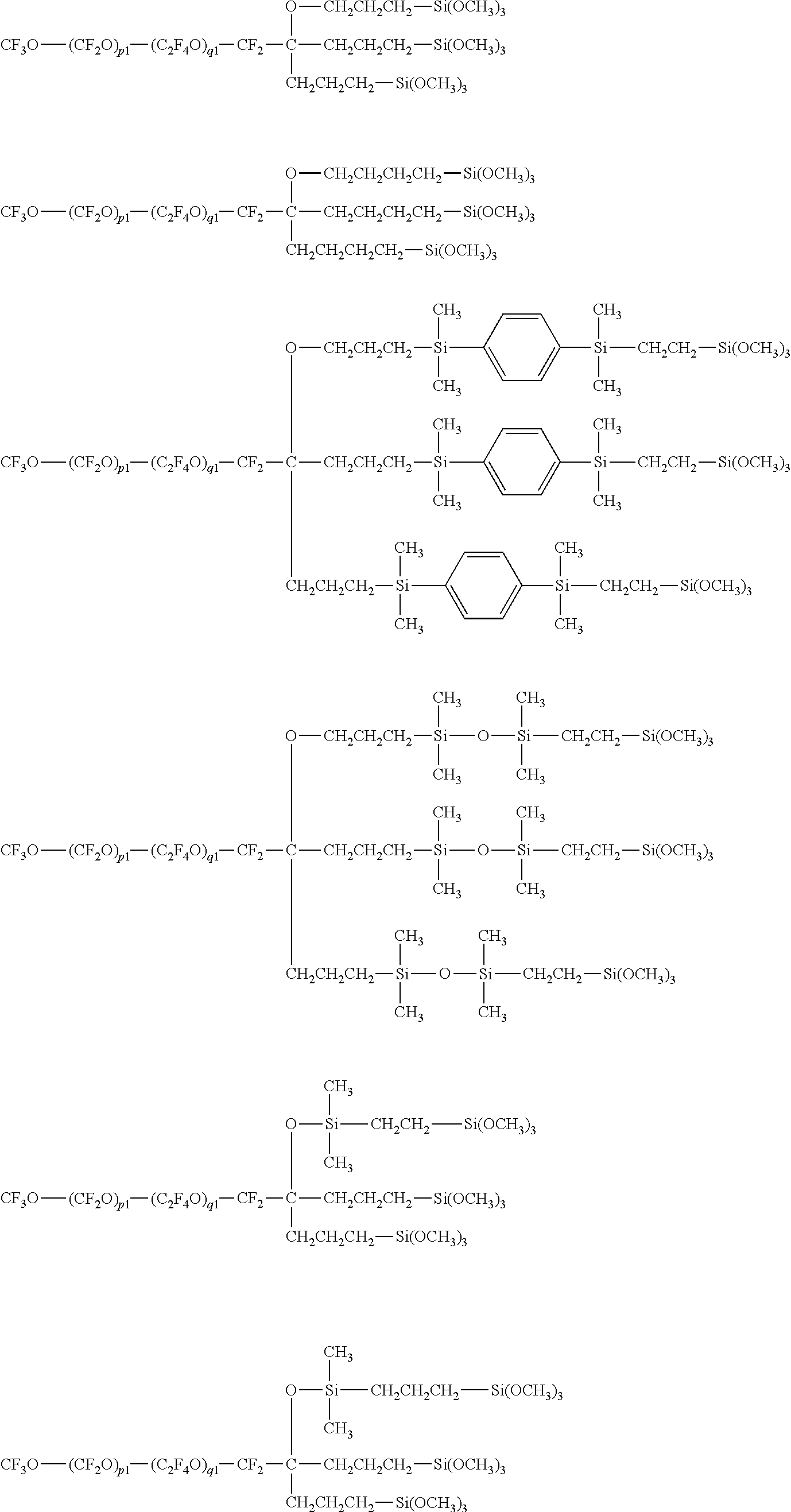Fluoropolyether-containing polymer-modified silane, surface treating agent, and treated article
a technology of fluoropolyether and surface treatment agent, which is applied in the direction of polyether coating, coating, etc., can solve the problems of non-tackiness and non-adhe screen exposed state, and poor adhesion to other substrate materials, so as to improve substrate adhesion, improve substrate adhesion, and improve the effect of adhesion
- Summary
- Abstract
- Description
- Claims
- Application Information
AI Technical Summary
Benefits of technology
Problems solved by technology
Method used
Image
Examples
example 1
[0176]The following were mixed together in a reactor: 300 g (8.3×10−2 mol) of the compound of formula (A) below
50 g (4.2×10−1 mol) of allyl bromide, and 0.6 g (1.7×10−3 mol) of tetrabutylammonium iodide. Next, 23 g (4.2×10−1 mol) of potassium hydroxide was added, following which the mixture was heated 6 hours at 70° C. After the completion of heating, the system was cooled to room temperature and an aqueous hydrochloric acid solution was added dropwise. The fluorocarbon compound layer on the bottom was recovered by a separatory operation and washed with acetone. The fluorocarbon compound layer on the bottom after washing was again recovered and the remaining solvent was driven off by distillation under reduced pressure. The above operations were again carried out, giving 270 g of the fluoropolyether-containing polymer of formula (B) below.
[0177]1H-NMR[0178]δ 2.4-2.6 (C—CH2CH═CH2) 4H[0179]δ 4.0-4.1 (O—CH2CH═CH2) 2H[0180]δ 4.9-5.2 (—CH2CH═CH2) 6H[0181]δ 5.7-5.9 (C—CH2CH═CH2) 3H
[0182]T...
example 2
[0188]The following were mixed together in a reactor: 100 g of 1,3-bis(trifluoromethyl)benzene, 0.028 g (5.4×10−4 mol) of tris(pentafluorophenyl)borane, and 100 g (2.7×10−2 mol) of the compound of formula (A) below.
Next, 3.8 g (3.8×10−2 mol) of dimethylallylsilane was gradually added dropwise, after which the mixture was heated 1 hour at 25° C. This was followed by the dropwise addition of water, subsequent to which the fluorocarbon compound layer on the bottom was recovered by a separatory operation and washed with acetone. The fluorocarbon compound layer on the bottom after washing was again recovered and the remaining solvent was driven off by distillation under reduced pressure, giving 95 g of the fluoropolyether-containing polymer of formula (D) below.
[0189]1H-NMR[0190]δ 0-0.2 (—Si—CH3)2—) 6H[0191]δ 1.5-1.7 (—Si—CH3)2—CH2—) 2H[0192]δ 2.3-2.6 (—CH2CH═CH2) 4H[0193]δ 4.7-5.2 (—CH2CH═CH2) 6H[0194]δ 5.7-5.9 (—CH2CH═CH2) 3H
[0195]The following were mixed together in a reactor: 90 g (2...
example 3
[0202]The following were mixed together in a reactor: 100 g of 1,3-bis(trifluoromethyl)benzene, 0.028 g (5.4×10−4 mol) of tris(pentafluorophenyl)borane, and 100 g (2.7×10−2 mol) of the compound of formula (A) below.
Next, 6.5 g (5.4×10−2 mol) of dimethylvinylsilane was gradually added dropwise, after which the mixture was heated 1 hour at 25° C. This was followed by the dropwise addition of water, subsequent to which the fluorocarbon compound layer on the bottom was recovered by a separatory operation and washed with acetone. The fluorocarbon compound layer on the bottom after washing was again recovered and the remaining solvent was driven off by distillation under reduced pressure, giving 99 g of the fluoropolyether-containing polymer of formula (F) below.
[0203]1H-NMR[0204]δ 0-0.2 (—Si—CH3)2—) 6H[0205]δ 2.4-2.5 (—CH2CH═CH2) 4H[0206]δ 4.7-5.2 (—CH2CH═CH2) 4H[0207]δ 5.6-6.2 (—CH2CH═CH2, —Si— (CH3)2—CH═CH2) 5H
[0208]The following were mixed together in a reactor: 90 g (2.4×10−2 mol) of...
PUM
| Property | Measurement | Unit |
|---|---|---|
| abrasion resistance | aaaaa | aaaaa |
| surface free energy | aaaaa | aaaaa |
| chemical resistance | aaaaa | aaaaa |
Abstract
Description
Claims
Application Information
 Login to View More
Login to View More - R&D
- Intellectual Property
- Life Sciences
- Materials
- Tech Scout
- Unparalleled Data Quality
- Higher Quality Content
- 60% Fewer Hallucinations
Browse by: Latest US Patents, China's latest patents, Technical Efficacy Thesaurus, Application Domain, Technology Topic, Popular Technical Reports.
© 2025 PatSnap. All rights reserved.Legal|Privacy policy|Modern Slavery Act Transparency Statement|Sitemap|About US| Contact US: help@patsnap.com



